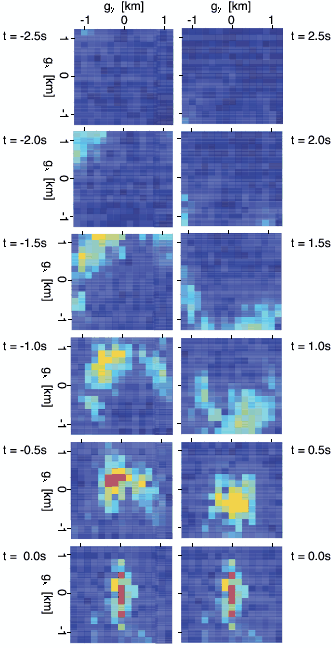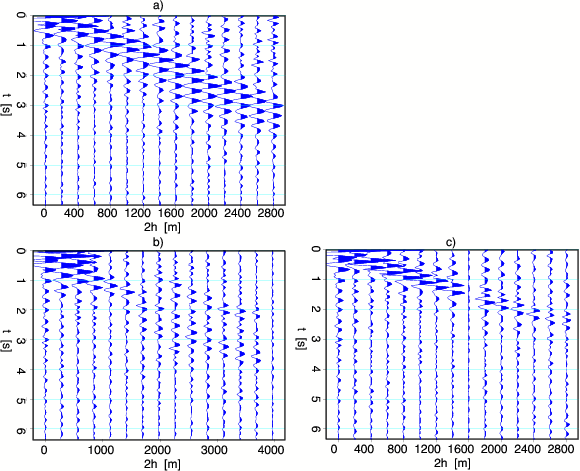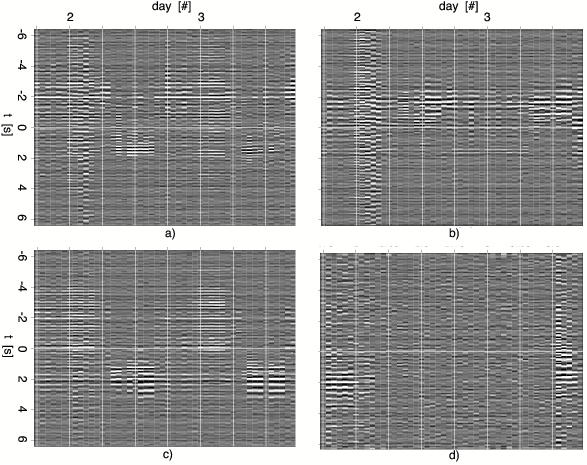 |
 |
 |
 | Low frequency passive seismic interferometry for land data |  |
![[pdf]](icons/pdf.png) |
Next: Spatial variability and dispersion
Up: de Ridder: Low frequency
Previous: Ambient seismic wavefield
Since the coherent ambient seismic field (as recorded by the array) is dominated by surface waves, a low-pass filter of 6.5 Hz was applied to extract the low-frequency surface wave energy. The recordings at all stations are correlated with the recording at one master station, effectively creating a virtual source at that master station. This procedure is repeated using each station as a master station, creating a virtual seismic survey with sources at each station location. The theory of seismic interferometry indicates that the cross-correlation between two recordings should, under equipartitioned energy circumstances, retrieve a time-symmetric Green's function between the stations (Wapenaar, 2004). In Figure 6 the envelope of the Green's functions for a virtual source at
 m is shown as a series of time slices, computed using all 48 hours of data. The Green's functions are not time-symmetric, which can be expected given the directionality of the ambient seismic field at frequencies below 6 Hz. However, the Green's functions are also not symmetric in space. The retrieved Rayleigh wave travels faster through the east than through the west part of the array. The capacity to retrieve longer offsets with less recording is studied by selecting a virtual source at the west end of the array and correlating all recordings between 20:00 and 21:00 on day 1. Figure 7 shows three slices through the correlation cube; a
m is shown as a series of time slices, computed using all 48 hours of data. The Green's functions are not time-symmetric, which can be expected given the directionality of the ambient seismic field at frequencies below 6 Hz. However, the Green's functions are also not symmetric in space. The retrieved Rayleigh wave travels faster through the east than through the west part of the array. The capacity to retrieve longer offsets with less recording is studied by selecting a virtual source at the west end of the array and correlating all recordings between 20:00 and 21:00 on day 1. Figure 7 shows three slices through the correlation cube; a  -slice, a
-slice, a  -slice and a third diagonal slice (see Figure 1). Although the directionality in the ambient seismic field is favorable for retrieving along the diagonal of the correlation cube, correlating one hour of data was not sufficient to achieve convergence for a Green's function along the long offsets of the diagonal slice. For the smaller offsets along
-slice and a third diagonal slice (see Figure 1). Although the directionality in the ambient seismic field is favorable for retrieving along the diagonal of the correlation cube, correlating one hour of data was not sufficient to achieve convergence for a Green's function along the long offsets of the diagonal slice. For the smaller offsets along  and
and  -slices, one hour of data was sufficient to achieve reasonable convergence. The move-out of the arrivals indicate a velocity of approximately 1000 m/s.
-slices, one hour of data was sufficient to achieve reasonable convergence. The move-out of the arrivals indicate a velocity of approximately 1000 m/s.
The quality of the retrieved Green's functions depends on the portion of data used and the directionality in the ambient seismic field. To illustrate this, a correlation was computed using each hour of data, for a virtual source at
 m and stations at the 4 corners of the array. The gathers are shown in Figure 8. The time asymmetry of the retrieved result can be linked to the directionality of the ambient seismic field. For example, for the retrieved signals on day 1 using the data recorded from 20:00 to 21:00, the energy in the correlations is dominantly causal for the station in the south and dominantly acausal for the station in the north, which is consistent with the observation that energy is traveling southwards for this time period. A high concentration of energy arriving at a station focused at approximately
m and stations at the 4 corners of the array. The gathers are shown in Figure 8. The time asymmetry of the retrieved result can be linked to the directionality of the ambient seismic field. For example, for the retrieved signals on day 1 using the data recorded from 20:00 to 21:00, the energy in the correlations is dominantly causal for the station in the south and dominantly acausal for the station in the north, which is consistent with the observation that energy is traveling southwards for this time period. A high concentration of energy arriving at a station focused at approximately  s corresponds to a good convergence rate. The observed convergence rates can be related to the strength of the ambient seismic field (see the frequency spectra of figure 2). Notice the crisp causal Green's functions for daylight hours arriving at the south station.
s corresponds to a good convergence rate. The observed convergence rates can be related to the strength of the ambient seismic field (see the frequency spectra of figure 2). Notice the crisp causal Green's functions for daylight hours arriving at the south station.

|
|---|
CenterG
Figure 6. Snap shots of a movie of the acausal (left) and causal (right) parts of retrieved Green's functions for a virtual source at
 m.
m.
|
|---|
![[pdf]](icons/pdf.png) ![[png]](icons/viewmag.png)
|
|---|

|
|---|
Glongoffset
Figure 7. Causal retrieved Green's functions plotted as a function of full offsets (2h) for a source positioned at
 m. a) A
m. a) A  -slice at
-slice at  m; b) a
m; b) a  -slice at
-slice at  m and; c) a diagonal slice.
m and; c) a diagonal slice.
|
|---|
![[pdf]](icons/pdf.png) ![[png]](icons/viewmag.png)
|
|---|

|
|---|
TGcomplete
Figure 8. Green's functions for a virtual shot gather of a source positioned at
 m and stations at; a)
m and stations at; a)
 m; b)
m; b)
 m; c)
m; c)
 m; d)
m; d)
 m.
m.
|
|---|
![[pdf]](icons/pdf.png) ![[png]](icons/viewmag.png)
|
|---|
 |
 |
 |
 | Low frequency passive seismic interferometry for land data |  |
![[pdf]](icons/pdf.png) |
Next: Spatial variability and dispersion
Up: de Ridder: Low frequency
Previous: Ambient seismic wavefield
2010-05-19
![]() m and stations at the 4 corners of the array. The gathers are shown in Figure 8. The time asymmetry of the retrieved result can be linked to the directionality of the ambient seismic field. For example, for the retrieved signals on day 1 using the data recorded from 20:00 to 21:00, the energy in the correlations is dominantly causal for the station in the south and dominantly acausal for the station in the north, which is consistent with the observation that energy is traveling southwards for this time period. A high concentration of energy arriving at a station focused at approximately
m and stations at the 4 corners of the array. The gathers are shown in Figure 8. The time asymmetry of the retrieved result can be linked to the directionality of the ambient seismic field. For example, for the retrieved signals on day 1 using the data recorded from 20:00 to 21:00, the energy in the correlations is dominantly causal for the station in the south and dominantly acausal for the station in the north, which is consistent with the observation that energy is traveling southwards for this time period. A high concentration of energy arriving at a station focused at approximately ![]() s corresponds to a good convergence rate. The observed convergence rates can be related to the strength of the ambient seismic field (see the frequency spectra of figure 2). Notice the crisp causal Green's functions for daylight hours arriving at the south station.
s corresponds to a good convergence rate. The observed convergence rates can be related to the strength of the ambient seismic field (see the frequency spectra of figure 2). Notice the crisp causal Green's functions for daylight hours arriving at the south station.


